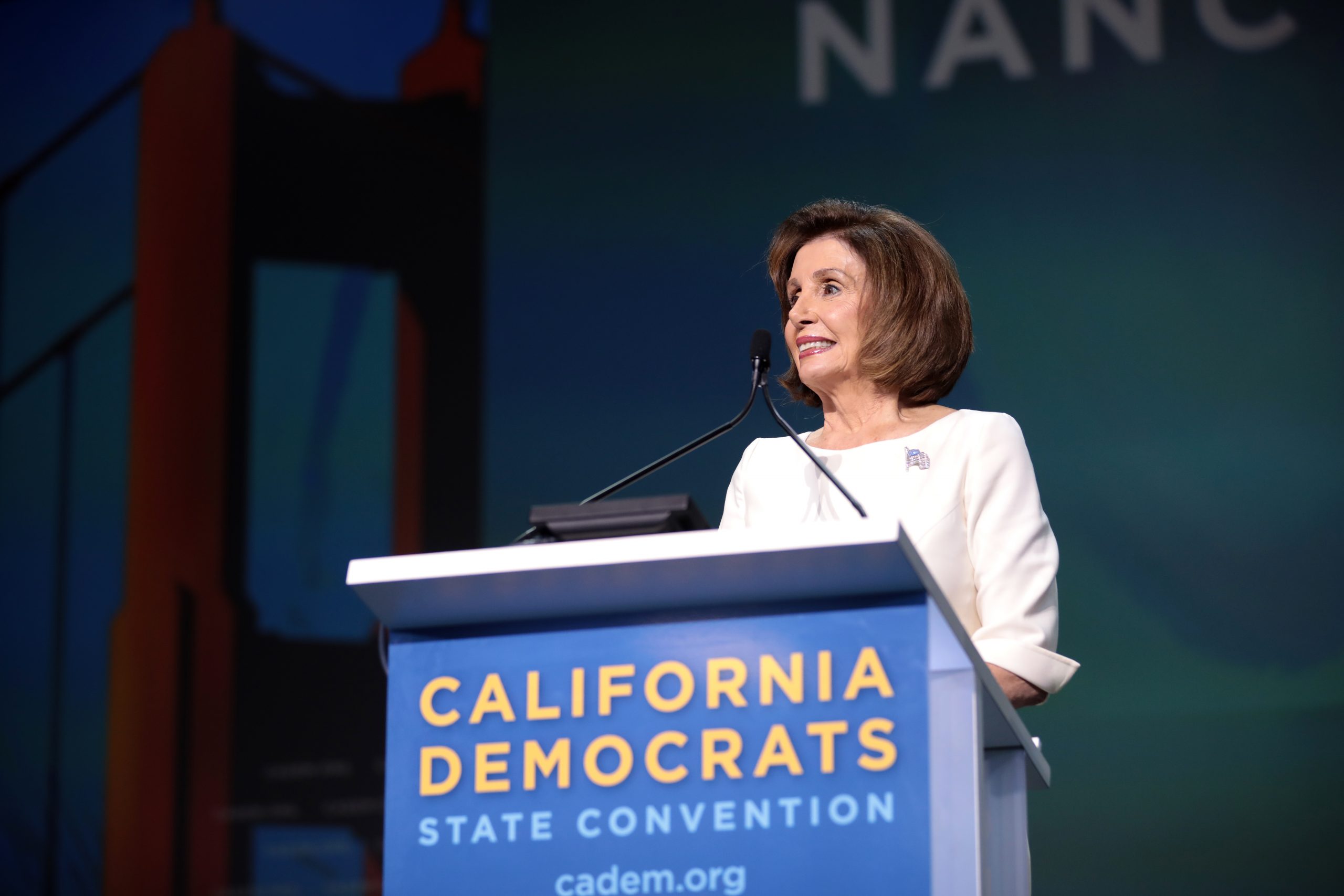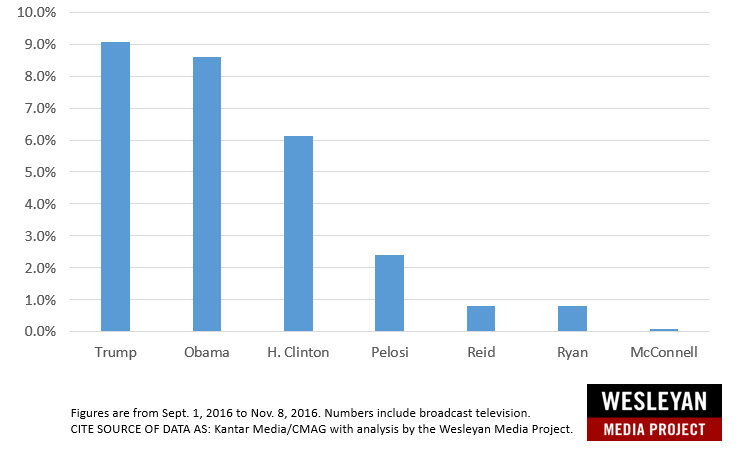Photo Gage Skidmore/Flickr
Pelosi is the Most Targeted Congressional Leader in the Past Three Cycles
![]()
(MIDDLETOWN, CT) April 9, 2018, with updates through June 4, 2018 – Along with many other aspects of campaign advertising, the Wesleyan Media Project has tracked mentions of prominent party leaders in political ads. More specifically, we have tracked references to Obama since 2010, mentions of congressional party leaders since 2012, and in 2016, we added references to both presidential nominees. Our coders also assess whether mentions of these political figures were favorable or unfavorable.
By and large, between 2012 and 2016, congressional leaders were not commonly the focus of unfavorable political ads during the general election phase of the campaign (those airing between September 1 and Election Day). See Figure 1. Obama was much more commonly cited than congressional leaders—and much more often in a disapproving way. Fifteen percent of congressional ads airing in 2012 cited him disapprovingly (the same percentage as 2010 ads), with only about 1 percent citing him in a supportive way. In 2014, however, the number jumped to nearly 1 in every 4 congressional ads. By 2016, though, this fell to about 1 in every 10 ads.
![]()
Figure 1: Percentage of Congressional Ad Airings Portraying
Each Leader Unfavorably Over Time
Figures are from Sept. 1 through election day of each cycle.
Numbers include broadcast television.
Data visualization work by Kevin McMorrow ’20.
CITE SOURCE OF DATA AS: Kantar Media/CMAG with analysis by the Wesleyan Media Project.
Download a summary table of figure data.
![]()
Running against congressional leaders is much less frequent tactic than running against an incumbent president. Democratic House leader Nancy Pelosi, for example, was referenced in only 3.5 percent of congressional ads in 2012 and in 3.6 percent of ads in 2014. Of the big four congressional leaders, however, Pelosi is the most commonly targeted at a rate much higher rate than any of the other four.
![]()
Trump Edged Out Obama in 2016
Focusing in on 2016, where we also tracked the two major party nominees, Figure 2 shows that unfavorable mentions of Trump actually overtook those of Obama (9.1 percent compared to 8.6 percent), with Clinton running a more distant third with 6.1 percent.
![]()
Figure 2: Percentage of 2016 Congressional Ad Airings Portraying
Each Leader Unfavorably
![]()
Pelosi Runs Second to Trump in 2018
In airings for U.S. House and U.S. Senate races between January 1, 2018 and June 4, 2018, unfavorable references to the president continue to outpace unfavorable mentions of congressional leaders. More specifically, Trump is featured unfavorably in nearly 13 percent of the nearly 300,000 televised congressional airings on local broadcast to date.
Pelosi continues to be the most targeted congressional leader – featured unfavorably in over 19,000 airings (6.5 percent), primarily from Republicans.
“Although presidents and presidential candidates are the most common target in congressional campaign ads, it is noteworthy that Pelosi has consistently been singled out more than any other congressional leader since 2010 despite her minority party status for the bulk of that time,” said Erika Franklin Fowler, co-director of the Wesleyan Media Project. “With Obama’s departure, Pelosi may become an even bigger target in advertising than we’ve seen in the past three cycles.”
Pelosi attacks far outpace the nearly 7,000 unfavorable references to Schumer (2.4 percent, all of whom also target Pelosi) and the mere 1,112 unfavorable mentions of Republican House Speaker Paul Ryan (0.4 percent of all airings) in pro-Democratic ads. Senate Majority Leader Mitch McConnell has received the fewest unfavorable mentions, only 908 airings so far.
Clinton Attacks More Prominent than Schumer
Interestingly, the third most commonly attacked candidate this cycle is Hillary Clinton, with over 15,000 unfavorable references (5.1 percent of all congressional airings through June 4, 2018). Clinton attacks are nearly as prevalent as Pelosi attacks, and both occur much more frequently than ads attacking Schumer.
“Somewhat surprisingly, Hillary Clinton continues to be a target in advertising,” said Travis Ridout, co-director of the Wesleyan Media Project. “Even though she is effectively out of politics now, Republicans continue to try to capitalize on their many voters’ dislike of the 2016 Democratic nominee.”
![]()
CORRECTION: A prior version of this report incorrectly reported the start date for the analysis as January 1, 2017, instead of January 1, 2018, which also affected the denominator and some of the figures. This updated post reports numbers for the period 1/1/2018 – 6/4/2018, which is consistent with the narrative released in April with the exception that for the period 1/1/2018 – 4/1/2018, unfavorable references to Schumer slightly outpaced those of Clinton (not the reverse as previously reported). Contact the WMP team at mediaproject@wesleyan.edu if you have additional questions about this report or the correction.
![]()
About This Report
Data reported here from Kantar/CMAG do not cover local cable buys, only broadcast television, national network and national cable buys. All cost estimates are precisely that: estimates.
The Wesleyan Media Project (WMP) provides real-time tracking and analysis of all political television advertising in an effort to increase transparency in elections. Housed in Wesleyan’s Quantitative Analysis Center – part of the Allbritton Center for the Study of Public Life – the Wesleyan Media Project is the successor to the Wisconsin Advertising Project, which disbanded in 2009. It is directed by Erika Franklin Fowler, associate professor of government at Wesleyan University, Michael M. Franz, professor of government at Bowdoin College and Travis N. Ridout, professor of political science at Washington State University. WMP staff include Laura Baum (Project Manager), Dolly Haddad (Project Coordinator) and Matthew Motta (Research Associate).
The Wesleyan Media Project is supported by Wesleyan University. Data are provided by Kantar Media/CMAG with analysis by the Wesleyan Media Project. WMP is partnering again this year with the Center for Responsive Politics, to provide added information on outside group disclosure.
Periodic releases of data will be posted on the project’s website and dispersed via Twitter @wesmediaproject. To be added to our email update list, click here.
For more information contact:
Lauren Rubenstein, lrubenstein@wesleyan.edu, (860) 685-3813
About Wesleyan University
Wesleyan University, in Middletown, Conn., is known for the excellence of its academic and co-curricular programs. With more than 2,900 undergraduates and 200 graduate students, Wesleyan is dedicated to providing a liberal arts education characterized by boldness, rigor and practical idealism. For more, visit wesleyan.edu.





